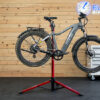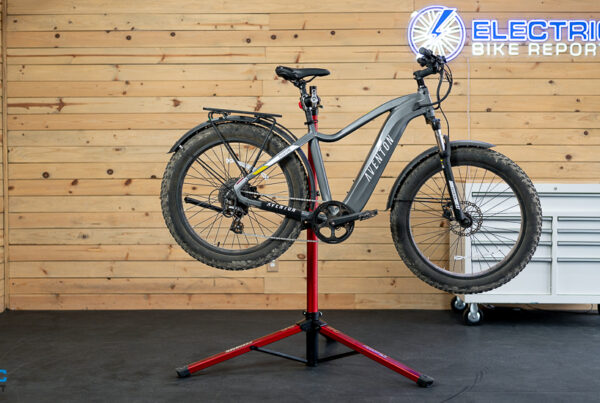A more subjective topic than our performance test sections above, ride quality is a measure of how a bike functions and feels to ride. Overall, the M2 Pro met our expectations and, in some cases, pleasantly surprised us—though it’s important to note that there are a few potential tradeoffs for its remarkably affordable price.
Aipas’s website states that the bike is sized for riders between 5’8” and 7’0”, making it suitable for riders of relatively average height to those who are extremely tall. Based on my personal experience, however, the high end of the bike’s advertised height range seems hopeful.
At 5’11”, I felt generally comfortable while riding the bike, but I would likely make some adjustments for personal comfort, with the first item being a longer seatpost. The M2 Pro offers just 4 inches of saddle height adjustment, and even with the saddle at its highest, my knees were bent more than I prefer for pedaling efficiency.
With that in mind, it’s important to note that the motor and pedal assist system are powerful enough to largely offset the difference; I never felt pain or discomfort in my knees from the pedaling position.
The bike’s reach felt appropriate and comfortable, with ergonomically-curved handlebars positioning my upper body in a mostly-upright posture. I also liked the saddle and rubber grips. The overall riding position felt slightly sporty but also relaxed and strain-free.
A major appealing feature of the M2 Pro is its full suspension, which includes a coil shock at the tail end and a coil fork with 100mm of travel. The combination of the bike’s suspension and fat tires made the ride smooth and enjoyable, though the bike could be a bit creaky at times.
As far as handling goes, the bike steered predictably, but due to its weight and long wheelbase, it wasn’t the most nimble e-bike I’ve tested. In comparison with other fat tire e-bikes, it wasn’t too far from the norm, but riders who are used to a “regular” bike may be somewhat surprised by its size; maneuvering it while off the bike and/or lifting it onto a vehicle rack may require some effort.
The M2 Pro’s tires, as is typical for a fat tire e-bike, provide great stability while riding, and include knobby tread for traction in off-road environments. These factors make this style of bike popular for both comfort and versatility; fat tires feel confidence-inspiring when cornering and capable of handling loose, slippery terrain.
Operating the bike is generally simple and straightforward; the user interface is relatively basic. In addition to the central color display, the left handlebar hosts a control panel and a module for the lights and horn, while the right side has a twist throttle and over-the-bar thumb shifter for the 7-speed drivetrain.
As one might expect for an e-bike under $1,000, the M2 Pro uses a number of entry-level components, including its drivetrain. The combination of a twist throttle and over-the-bar shifter is not uncommon in our experience, but we typically prefer the trigger-style shifter common with 8-speed drivetrains to the M2’s thumb shifter—especially when riding off-road.
It’s inevitable that e-bikes in this price tier have to make some compromises with their components, so I cannot fault Aipas for outfitting the bike as it comes, but it’s important to consider that some parts may need more frequent maintenance as a result. The M2 Pro’s suspension, for example, performed well in our (mostly on-road) testing, but we can’t speak to its longevity with prolonged exposure to rough off-road conditions.
Overall, I found the M2 Pro to be comfortable and generally well-equipped for its price. Aipas seems to have found a great balance between comfort, price, and performance; the bike offers many appealing features, including a smooth, easy, and speedy ride.
.
.
.
#Aipas #Pro #Review #BudgetTier #Fat #Bike #Delivers
Source link








